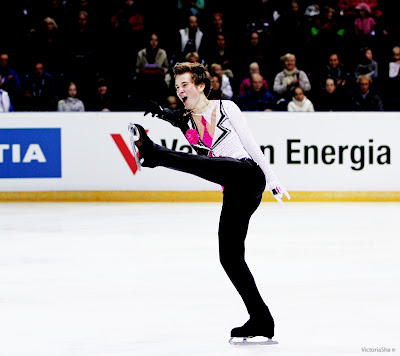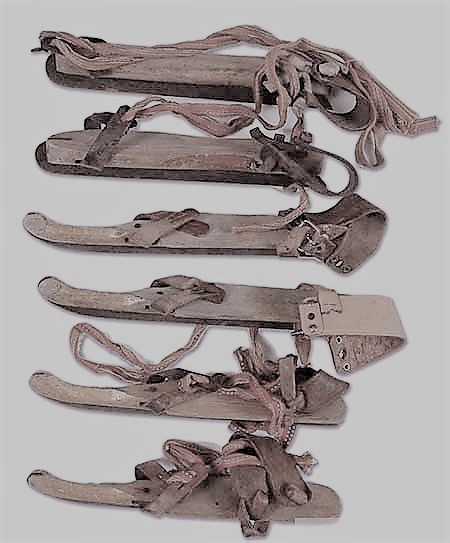In my previous "Return To Open Pro Competitions" articles, I took an in depth look at the U.S. Open and Jaca World Professional Figure Skating Championships. In an effort to preserve some of the history and stories of professional figure skating competition, I'm once again taking a walk down memory lane and this time examining the history of the Miko Masters professional figure skating competition. Held 12 times consecutively from 1991 to 2002, this prestigious competition was held annually at the Palais Omnisports de Paris-Bercy at the 12th arrondissement in Paris, France. From 1991 to 1999, the competition at this event was strictly for professional skaters and in the final two years the event was held it took on a pro-am format. Furthermore, the competition from 1991 to 1996 was divided by discipline, whereas beginning in 1997 until the event was last held in 2002, a team format was adopted. In addition to competitive performances, exhibitions were always a big part of the Miko Masters, and often allowed top eligible French and international skaters to shine. What made Miko Masters quite unique was that it was one of few professional competitions that really took advantage of elaborate stage lighting at the time. When the skaters performed their artistic programs, it was under theatrical lighting and great care was put into creating an atmosphere with the skater's music, lighting, costuming and performance itself.
In 1992, the event became officially known as the Miko Masters and many competitors from the Albertville Winter Games were invited to participate. Exhibition performances included 1992 Albertville pairs and dance winners Natalia Mishkutenok and Artur Dmitriev and Marina Klimova and Sergei Ponomarenko and the event also marked the first time Victor Petrenko, Paul Wylie and Petr Barna (the medallists in Albertville) competed against each other as professionals. With a program to Chubby Checker's "Let's Twist Again" and solid jumps, Petrenko bested both Wylie and Barna to take the men's title and it was 1981 World Champion Denise Biellmann who secured the women's title, ahead of Jill Trenary, Caryn Kadavy and others, skating to "Le Jazz Hot" from "Victor/Victoria" and "What Child As This?" as her technical and artistic program, respectively.
Elena Bechke and Denis Petrov showing off their Miko Masters trophies
Broadcast by thirty seven television channels, the third edition of the competition again proved historic. A pairs competition was added to the men's and women's events, and the number of competitors in each discipline was reduced to four. The first pairs title at Miko Masters was won by 1992 Olympic Silver Medallists Elena Bechke and Denis Petrov. They skated to music from the 1862 Italian opera "La Forza Del Destino" by Giuseppe Verdi. They finished ahead of Christine Hough and Doug Ladret, 1984 Olympic Gold Medallists Elena Valova and Oleg Vasiliev and Anita Hartshorn and Frank Sweiding. Paul Wylie rebounded from a disappointing sixth place finish the year prior to win the men's event with his legendary "JFK" program, ahead of Petr Barna, Scott Williams and Brian Orser. The women's competition was won by Caryn Kadavy, whose "I Dreamed A Dream" program from "Les Miserables" swayed the judges more than Denise Biellmann's "Drums/As Yet Untitled" avant garde artistic program. Claudia Leistner (in a rare professional competitive appearance) and Charlene Wong finished third and fourth.
Sandra Garde
Following the hugely popular 1994 Winter Olympic Games in Lillehammer, audiences for professional events were at all-time high. The 1994 Miko Masters was a roaring success, with the pairs competition being dropped for this year only and five men and five women competing in both technical and artistic programs. The men's competition marked four-time World Champion Kurt Browning's first professional competition, and he finished second to Paul Wylie, who defended his title with yet another movie soundtrack from his growing repertoire - "The Untouchables". Alexandr Fadeev, Petr Barna and the late Robert Wagenhoffer finished third, fourth and fifth in the men's event. In the women's competition, Denise Biellmann won her second Miko Masters title with two technically sound and avant garde programs. Her "Rite Of Spring" just edged out two-time Olympic Gold Medallist Katarina Witt skating to a French version of "On My Own" from "Les Miserables", who was also competing in her first professional event since her 1994 comeback to "amateur" skating. Caryn Kadavy finished third, Rory Flack Burghart was fourth and theatrical French skater Sandra Garde, who won the Trophee Lalique audience judged pro competition in France, was fifth. Exhibition performances in 1994 included Swiss spinning sensation Nathalie Krieg, Philippe Candeloro and Sophie Moniotte and Pascal Lavanchy.
Philippe Candeloro
After making his first appearance of many at the Miko Masters in 1994, Philippe Candeloro returned in 1995 with Miko as his main partner, bringing some of the best skaters from the French national team along with him for exhibitions, including Surya Bonaly, Eric Millot and Sophie Moniotte and Pascal Lavanchy. Candeloro and Bonaly prepared a pairs program, which they performed for the first time at this event together. Exhibitions were also skated by 2 time Olympic Gold Medallists Ekaterina Gordeeva and Sergei Grinkov and 1991 World Champions Isabelle and Paul Duchesnay. The competition, which was televised both overseas and in North America on ESPN and TSN, saw the pairs return to the spotlight and Anita Hartshorn and Frank Sweiding take home the title. In the men's event, Paul Wylie won his third consecutive Miko Masters title, showing his passionate "Schindler's List" program under theatrical lighting. Jozef Sabovcik skated a curious program in overalls to "Ol' Man River" from "Showboat" to finish second, ahead of Scott Williams, Petr Barna and Alexandr Fadeev. In the women's event, Denise Biellmann's acrobatic and driving "Test Overdub/Frantic" wowed the judges and audience alike, and she was able to overtake Yuka Sato, Liz Manley, Caryn Kadavy, and Sandra Garde to win the women's title. Sandra Garde's very theatrical "Night On Bald Mountain" artistic program in this event, developed from a free skating program she used at the World Junior Championships in the late 80's, was a must see. Although her hardest jump was a double loop, her choreography, costuming and musicality were simply unforgettable.
Surya Bonaly
In 1996, pairs skating was in the spotlight. The best performance in the pairs event, that of 1995 World Champions Radka Kovarikova and Rene Novotny, was awarded the Sergei Grinkov prize in tribute to Grinkov, who passed away in November 1995. They placed ahead of Hartshorn and Sweiding and Urbanski and Marval. Another innovation to the competition was a prize for best jump, which was awarded at the end of the men's, women's and pairs technical programs. For the fourth time, Denise Biellmann took the women's title, this time besting Caryn Kadavy, Yuka Sato, Charlene von Saher and Rory Flack Burghart. Among the men, Paul Wylie also won his fourth title, finishing ahead of Scott Williams, Alexandr Fadeev and Jozef Sabovcik. Surya Bonaly was among the special guests performing exhibitions. In a forerunner to the later Improv-Ice event, the audience chose music for the exhibitions at the event, which skaters then improvised. In association with Guépard Production (Juliette Leclercq), Miko announced financial support for young French skaters under the age of 16 at this event. This was the last year individual competitions were held.
Olga Markova
Keeping with the changing times, things changed again in 2000, when the event kept its team format but switched to a FFSG approved "Open de France" pro-am competition between Russia and France. All skaters participating skated an ISU approved short program in addition to an interpretive free program. Team France (Eric Millot, Stannick Jeannette, Vanessa Gusmeroli, Abitbol and Bernadis and Anissina and Peizerat) edged Team Russia (Alexei Yagudin, Maria Butyrskaya, Olga Markova, Totmianina and Marinin and Lobatcheva and Averbukh) for the win. Full results and scores from the 2000 event can be found at http://www.eiskunstlauf-ecke.de/archiv/1999-00/mastersmiko00.shtml.
The Miko Masters competition returned in 2001 with the pro-am team two program format retained and skaters from France this time competing against a World team. France's team, lead by Marina Anissina and Gwendal Peizerat and Vanessa Gusmeroli, upset the World Team, which included Lu Chen, Alexei Urmanov and Margarita Drobiazko and Povilas Vanagas. Two-time French National Champion Laetitia Hubert performed exhibitions at this event as well, to the music of Charles Aznavour and Kylie Minogue's "Can't Get You Out Of My Head".
In 2002, the competition was last held following the Salt Lake City Games. A team format was again adopted, with competitors including Brian Joubert, Laetitia Hubert, Marina Anissina and Gwendal Peizerat, Alexander Abt, Tatiana Totmianina and Maxim Marinin. Team Russia won the overall competition in 2002.
What made competitions like the Miko Masters so special was the commitment to presenting professional skating in a way that was relatable to the audience. With easy to understand competition formats and a focus on creating an atmosphere for magical performances by providing top notch theatrical lighting, the programs that the skaters performed at this event over the years really shined as brightly as they could have. In looking through the history of competitions such as these, we can only be reminded of the impact artistic and professional skating have made on the sport and the very real future they have.
Skate Guard is a blog dedicated to preserving the rich, colourful and fascinating history of figure skating. Over ten years, the blog has featured over a thousand free articles covering all aspects of the sport's history, as well as four compelling in-depth features. To read the latest articles, follow the blog on Facebook, Twitter, Pinterest and YouTube. If you enjoy Skate Guard, please show your support for this archive by ordering a copy of the figure skating reference books "The Almanac of Canadian Figure Skating", "Technical Merit: A History of Figure Skating Jumps" and "A Bibliography of Figure Skating": https://skateguard1.blogspot.com/p/buy-book.html.






















